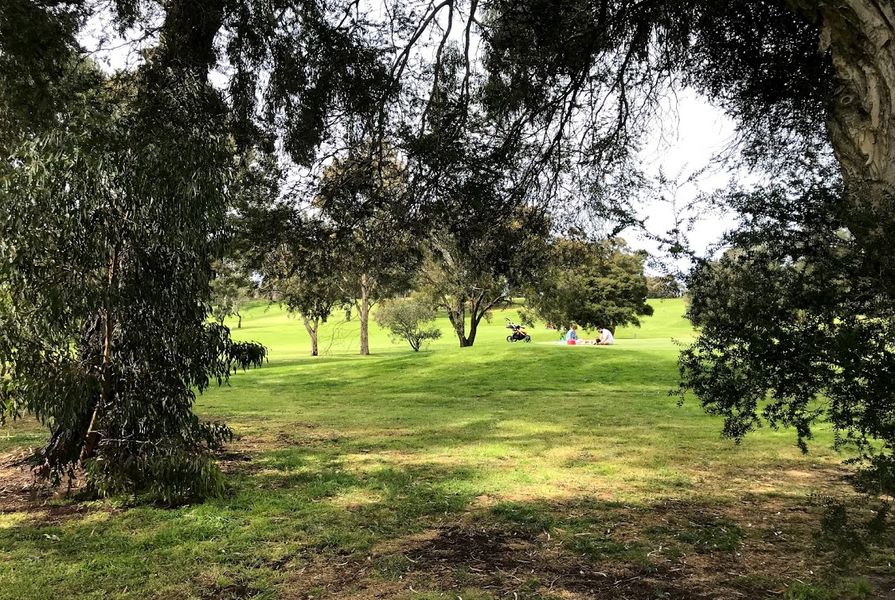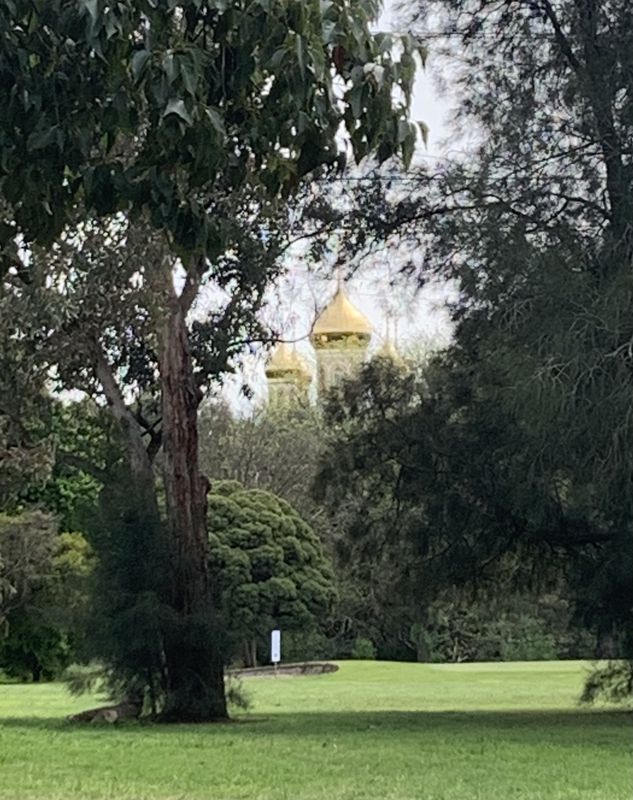In late September, in response to a local desire for open space, the Northcote Golf Course in Melbourne’s inner-north was opened for public access. The chainlink fence had been repeatedly cut open but now the main gates of the golf course are open to all. The 24-hectare site has since attracted thousands of visitors, aided by the recently completed pedestrian bridge over the Merri Creek, which has connected the suburb of Brunswick East to the local government area of Moreland.1 The golf course is attracting a diversity of users seeking a place of rest, relaxation and social gathering. For the demographic of the inner-north, these are activities usually associated with cafes and bars. While we are all keen to return to the beer garden and other post COVID-19 activities, the “people’s park” offers valuable insight into understanding how urban outdoor spaces in Melbourne can contribute to the community, beyond conventional notions of functionality and formal recreation.
Entering the golf course invokes a celebratory feel, as people gather in small groups around the greens and explore the roughs under the trees. This experience is a welcome relief for many, who have spent weeks trekking up and down the Merri Creek corridor or walking (literally in circles) around the smaller parks which dot the city’s inner suburbs. Given the relatively high number of urban parks in the inner-north area, and the access to creek systems, why is accessing the golf course so exciting and so popular?
The Northcote Golf Course – a highly designed and carefully maintained landscape of trees, native grasses and topography.
Image: Wendy Walls
The answer lies in the quality of the space, in its size and carefully designed experience. All of which is rare in our increasingly dense and urbanized inner northern suburbs. By venturing into the golf course, the public is offered the experience of a meticulously crafted landscape. A quick “Google” of “how to design a good golf course,” for instance, brings up categories such as “natural beauty,” “impeccable maintenance” and “comfortable elegance.” The combination of these golf course design goals produces a very different parkland to the usual Australian model of a footy oval bordered by a couple of Eucalyptus trees.
Instead, here we have a space of rolling topography, where the beautiful greens contrast with the native grasses. The fairways frame views, for instance, drawing the gaze beyond the immediate greens to a distant Russian Orthodox church or a long view back to the city skyline. The landscape space is continuous, uninterrupted by formal path systems or cricket grounds, bowling greens or play equipment. Even when teeming with new visitors, it remains a quiet contemplative space. More so, it is a cared-for and cultivated space.
A view from a fairway at Northcote Golf Course draws the viewer’s gaze beyond the immediate greens to a Russian Orthodox church in the distance.
Image: Jillian Walliss
The past six months of COVID-19 lockdowns has sparked extensive discussions about the future of our cities and lifestyles, with the importance of local parks gaining much attention. Much conversation, for example, has centred around equity in accessing parks within the five kilometre radius, as well as issues relating to walkability, housing and the measured health and wellbeing effects of being outdoors.2 What is missing from these discussions is the quality of the spaces being provided.
Melbourne is a city defined by quantity not quality. While we can point to some striking examples of parks and gardens – Royal Park, the Royal Botanic Garden sVictoria, All Nations Park and our heritage inner-city parks, most of our urban green areas are defined and delivered by numbers. From walking times to tree percentage targets, planners and politicians have favoured metrics to guide decisions, where an explicit discussion of quality is largely absent.
The results of this approach are evident in the experience of our open space. Flat and functional describes so many of our suburban parks, sometimes joined by the linear paths which are now teeming with pairs of walkers, joggers, and cyclists. Our parks are zoned-out recreational spaces, while our green linear connections offer functional routes. While these green links pass through Melbourne’s unique environment – without the careful curation of quality, these spaces are strained. The quality in these spaces was never designed in the first place. Now, with ongoing COVID restrictions and improving weather, overuse of open spaces will only continue to reduce the quality of these sites.3
There is a growing community campaign for the Northcote Golf Course to become a shared space, not one exclusively for golfers. Local residents have formed a Community to Unlock Northcote Golf Course private Facebook group, which, at the time of writing, had more than 2000 members.4 With the lease of the golf course set to expire in mid-2022, this will in all likelihood turn into a political battle, pitting golfers, local government and community action groups against each other. And more numbers will likely be used to determine the outcome. But perhaps we can use this moment to build a more nuanced approach to open space, recognizing that there are other ways of understanding how open space can contribute, beyond metrics and rudimentary ideas of function. And that spaces can be managed and shared across diverse users, both public and private. Faced with increasingly hot summers, why couldn’t the public gain access to the golf course over selected summer periods? But most importantly, let’s start to value our parks as community investments in the same way we consider public libraries, which are increasingly designed with high attention to experience, materiality and aesthetics. We shouldn’t have to cut a hole through a golf course fence to experience these same qualities in our urban open spaces.
1. Clay Lucas, “Time to breach the bunkers and flock to the fairways,” The Age website, 26 September 2020, https://www.theage.com.au/politics/victoria/time-to-breach-the-bunkers-and-flock-to-the-fairways-20200925-p55zeg.html, accessed 7 October 2020
2. Ali Lakhai, Dennis Wollersheim, Elizabeth Kendall and Prosper Korah, “340,000 Melburnians have little or no parkland within 5km of their home,” The Conversation website, 12 August 2020, https://theconversation.com/340-000-melburnians-have-little-or-no-parkland-within-5km-of-their-home-144069 (accessed 7 October 2020); Wendy Stone, Amity James, Sharon Parkinson and Steven Rowley, “How might COVID-19 change what Australians want from their homes?” The Conversation website, 17 September 2020, https://theconversation.com/how-might-covid-19-change-what-australians-want-from-their-homes-145626, (accessed 7 October 2020); Sarah Metcalfe, “Daily exercise rules got people moving during lockdown – here’s what the government needs to do next,” The Conversation website, 5 August 2020, https://theconversation.com/daily-exercise-rules-got-people-moving-during-lockdown-heres-what-the-government-needs-to-do-next-143773, accessed 7 October 2020
3. Natalie Campbell, “New map shows Melbourne’s parks will struggle in next stage of lockdown,” RMIT website, 23 September 2020, https://www.rmit.edu.au/news/all-news/2020/sep/map-shows-melbourne-parks-will-struggle-in-next-stage-of-lockdown, accessed 7 October 2020
4. Catherine Ford, “It’s time to open up golf courses to all,” The Age website, 28 September 2020, https://www.theage.com.au/national/victoria/it-s-time-to-open-up-golf-courses-to-all-20200928-p55zw0.html, accessed 7 October 2020
















